Response of Cockscomb (Celosia Amigo) to various levels of Phosphorus and Nitrogen
Wiqar Muhammd1*, Jalal Amin1, Muhammad Imtiaz1, Anwar Shah1, Muhammad Musa Khan1, Farman Ghani1, Nawab Ali2, Muhammad Mehran Anjum2, Muhammad Riaz1 and Abid Alis1
1Department of Horticulture, University of Agriculture, Pakistan
2Department of Agronomy, University of Agriculture, Pakistan
Submission: December 19, 2017; Published: January 16, 2018
*Corresponding author: Wiqar Muhammd, Department of Horticulture, University of Agriculture, Peshawar, Pakistan Email: wiqarmahammad147@yahoo.com
How to cite this article: Wiqar Muhammd, Jalal Amin, Muhammad Imtiaz, Anwar Shah, Muhammad Musa Khan, Farman Ghani, et al. Response of Cockscomb (Celosia Amigo) to various levels of Phosphorus and Nitrogen. Int J Environ Sci Nat Res. 2018; 8(3): 555736. DOI: 10.19080/IJESNR.2018.08.555736.
Abstract
An experiment entitled "Response of cockscomb to various doses of nitrogen and phosphorus was carried out at ornamental nursery Cantonment Board Now shehra during June - August 2015. The experiment was laid out in randomized complete block design (RCB-Design) with two factors, factorial arrangement having three replication. Factor A included Nitrogen levels (0, 30, 45, 60,) and factor B included Phosphorus levels (0, 25, 50, 75). Maximum number of leaves plant-1 (57), leaf length (16.50cm), leaf fresh weight (41.58g), flower fresh weight (52g) and root length (25.33cm) were recorded at 45kg ha-1 nitrogen respectively. Maximum number of leaves plant-1 (57.08), leaf length (17.50cm), leaf fresh weight (40.75g), flower length (10.88cm), flower fresh weight (54.50g) and root length (24.42cm) were recorded at 50kg ha-1 of phosphorus. It is concluded that optimum level of nitrogen and Phosphorus promotes many growth attributes of cockscomb while higher doses of nitrogen and Phosphorus results in reduced plant growth. Therefore Nitrogen recommended at 45 kg ha-1, while Phosphorus at 50 kg ha-1
Keywords: Cockscombs; Phosphorous and Nitrogen
Introduction
The cockscomb are annual dicotyledonous plants. The cockscomb flowers are also known as wool flower or brain celosias. The botanical name of cockscomb is Celosia amigo and belongs to the family amaranthaceous. Its name is derived from Greek word "kelos" mean "burned". Cockscomb is annual flower. The exact origin of cockscomb is unknown, although scholars assign its geographically origins to the dry slopes of Africa and India and the dry rocky regions of both North and South America [1]. The plant grows well in both, indoors and out door conditions. They are hard resistant to most of the diseases, although the place without shade and well-drained soil is perfect, as the plant are vulnerable to fungal diseases. The plant is mostly uses as an ornamental indoors plant. Their leaves and flowers also uses as food in South America, India and Western Africa.
The cockscomb has also medicinal value. It uses as treatment for blood clotting, intestinal worm (Tape worm), mouth sores, and eyes problems. The seed are used for chest problem and the flower are used for treating diarrhoea. The leaves are used as external dressing, as treatment for burn and sores, and its boiled vegetative parts are said to be slightly diuretic [2]. Celosia species range from Celosia argentia, Celosia cristata, Celosia leptostachya, Celosia nitida, Celosia palmeri, to Celosia spicata. There are about 60 species of annual or perennial Celosia. Cockscomb flower are found golden red and vibrant yellow, and have no fragrance [3]. Seed production is very high in these species, range from 200-700kg ha-1. One ounce of seed may be containing up to 43,000 seeds. One thousand seeds can be weight up to 1.0-1.2 grams. Cockscomb requires a large amount of nutrients, especially nitrogen, fertilizers with a nitrogen- phosphorus-potassium ratio of 3:1:2, 20:10:20, or 15:5:15 serve the cockscomb best. Regular fertilization is needed for celosia to reach its full vigor of 10-30 inches depending on the cultivar [3] . The liquid or granular fertilizer can be used for this plant [4] . Keeping the soil mostly moist but not drenched and also applies dry granular fertilizer with a spreader or by sprinkling around the plant of cockscomb by hand. Repeat the fertilization process once twice per month. In view of the above finding it can be concluded the Nitrogen and Phosphorus are the important nutrient to increase the flower production and improve the flower quality. Therefore an experiment designs "Response of cockscomb to various levels of Nitrogen and Phosphorus.
Objectives
a) To know an appropriate dose of Phosphorus for the higher production of cockscomb.
b) To investigate the suitable doses of Nitrogen for enhancing the flower production.
c) To study the interaction between Nitrogen and Phosphorus for the better growth and quality production of cockscomb.
Materials and Methods
An experiment entitled "Response of Cockscomb to various levels of Nitrogen and Phosphorus" was conducted at ornamental nursery cantonment Board Now shehra during June-Aug 2015.
Experimental design
The experiment was laid out in Randomized Complete Block Design (RCBD) with two factor arrangement. These two factors were used Nitrogen levels (0, 30, 45, 60) and phosphorus levels (0, 25, 50, 75) were applied randomly to every plastic bags.
Soil preparation
The media used in the plastic bags was prepared using silt, sand, and leaf mold at the ratio of 1:1:2, and DAP was applied as a "Phosphorus" source and Urea was applied as a "Nitrogen" source
Seedling preparation
One thousand seed of cockscomb were purchased from market. Seeds were sown in plastic bags filled with prepared media. The plastic bags were covered with green plastic sheet in order to avoid excess sunlight and rain.
Transplanting seedling
The seedling was shifted to plastic bags (one plant bag- 1). These plant were kept in shade for three days to prevent hardening for the direct exposure of sunlight. Hand weeding was done whenever required. Plants were irrigated regularly depend upon the soil moisture and climatic conditions. All the required technique was used. The bags were placed in Randomized complete Block Design (RCBD) Having three replication. Each replication contained 80 plants there were sixteen treatments and each treatment had five plants. These plant were fertilized at the third week of each month.
Study Parameters
The data was recorded of different parameters of cockscomb to their growth and flowering habitat. The data were recorded from three randomly selected plant in every treatment different parameters are observed as followed.
Number of leaves plant'1: Number of leaves plant-1 were counted from each treatment and every replication and their mean value was calculated
Leaf length (cm): The leaf length was measured by using leaf area meter and their average mean was calculated.
Leaf fresh weight (gm): The fresh weight of leaf was measured by digital balance and their mean was calculated.
Length of flower (cm): The length of flower was measure by using measuring tape and their mean was calculated.
Fresh weight of flower (gm): The fresh weight of flower was measured by digital balance and their mean value was calculated.
Root length (cm): The length of root was measured by using measuring tape and their mean value was calculated.
Results and Discussion
The research study of "Cockscomb" on the response to various levels of Nitrogen and phosphorus was carried out in ornamental nursery Cantoment Board Now shehra during June-August 2015. Data were collecting on various vegetative and flowering attributes. The (Tables 1-6) showed the data was collected on various vegetative growth parameters. The collected data are discussed below. The data in (Table 1) illustrated the mean values for number of leaves plant-1 and (Table- 1a) showed the analysis of variance (ANOVA). The statistical analysis (ANOVA) showed that the effects of Nitrogen and Phosphorus was significant, while their interaction was found non-significant. The mean value showed that the maximum number of leaves plant-1 (57.08) was observed at N2 (45) level followed by (53.92) at N3 (60) level, while the minimum number of leaves plant-1 was found at control. In case of phosphorus the maximum number of leaves plant-1 (50.9) was observed at P2 (50) level, followed by (49.33) at P3 (75) level, while the minimum number of leaves plant-1 was found at control level. Increase in number of leaves may be due to the fact of Nitrogen which promote cell division and cell enlargement in the leaf [5] . Same result were found by [6] who reported that maximum number of leaves was oberrved at 120kg N ha-1 [7] also reported that Nitrogen significantly increase number of leaves as compare to control. Phosphorus also play important role in enhancement of leaves. It has a key role in synthesis of nucleic acids (DNA or RNA), photosynthesis, proteins, lipids, respiration, sugar, amino acids, energy metabolism, and regulation of enzyme [8,9] also found the similar result in chrysanthemum.

Lsd @ 0.05 for N and P= 3.89
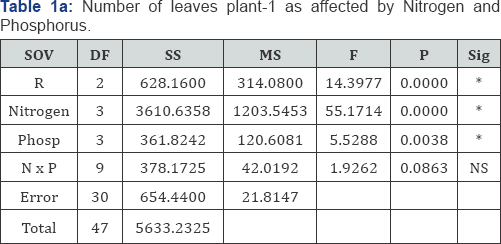
CV 9.7
Leaf length (cm)
The data in (Table 2) showed the mean value and (Table 2a) indicate corresponding analysis of variance (ANOVA) according to leaf length. The statistical analysis (ANOVA) showed that the effects of Nitrogen and Phosphorus was significant while their interaction was found non-significant. The mean value showed that the maximum leaf length (16.50cm) was observed at N2 45) level, followed by (15.0cm) at N3 (60) level, while the minimum leaf length was observed at control level. In case of Phosphorus the maximum leaf length (17.50) was observed at P2 (50) level, followed by (12.51) at P3 (75) level, while the minimum leaf length was found at untreated control level. Nitrogen and Phosphorus are the important element in the creation of Adenini Tri Phosphate which are essential for the forced required reaction and compound biosynthesis this result was supported by [10] and also reported that Nitrogen and Phosphorus increase the leaf length as compare to control.

LSD @ 0.05 for N and P=1.82
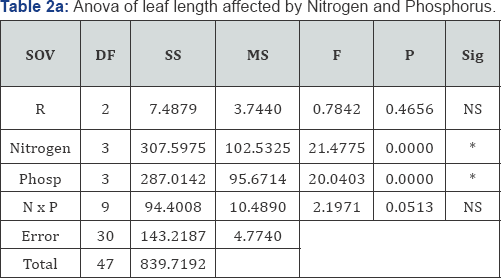
CV.16.37
Leaf fresh weight (g)
The data in (Table 3) showed the mean value and table- 3a displays the analysis of variance (ANOVA) of leaf fresh weight. The statistical analysis (ANOVA) showed that Nitrogen Phosphorus and their interaction was found significant. The mean value showed that the maximum leaf fresh weight (41.58g) was observed at 45kg N ha-1, followed by (39.67) at 60kg of Nitrogen ha-1, while the lowest leaf fresh was found at control level. In case of Phosphorus the maximum leaf fresh weight (40.75g) was observed at 50kg Phosphorus ha-1, followed by (37.67g) at 75kg phosphorus ha-1, while the minimum leaf fresh weight was observed at control level. The combine effect of Nitrogen and Phosphorus the mean value showed that maximum leaf fresh weight (44.33g) was observed at 45 N2 and P3 (75) level, followed by (43.67g) at N2 (45) and P2 (50) level. While the minimum leaf fresh weight was found at control level. [11] also reported that the nitrogen and phosphorus can significantly increase the leaf fresh weight as compare to control.
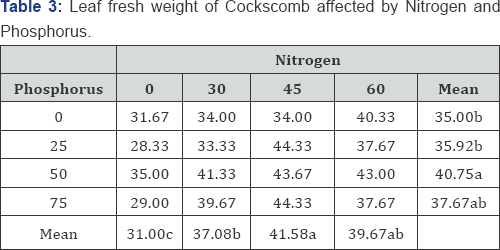
LSD value at 5% level of propability for Nitrogen and Phosphorus is =3.1 and N*P=6.Mean followed by different letters are significantly different using LSD test at 5% significance level.
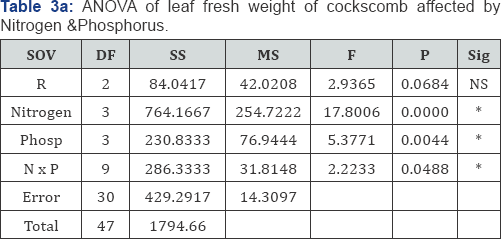
CV.10.13
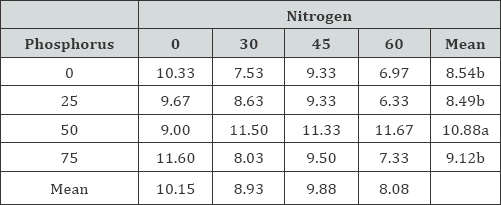
LSD @ 0.05 FOR P=1.7
Length of Flower (cm)
The data in the (Table 4) illustrate the mean value for length of flower and Table 4a showed the analysis of variance. The ANOVA showed that the effects of Phosphorus was significant while the effects of Nitrogen and their interaction was found non-significant. The mean value showed that the maximum length of flower (10.88cm) was found at P2 (50) level, followed by (9.1cm) at P3 (75) level, while the minimum flower length (8.5cm) was found at untreated control level. Phosphorus have a significant role in the enhancing of flower length. Phosphorus play a significant role in almost all the process that are involved in transfer of energy such as ATP and ADP that energy are required to regulate the plant process [12]. Phosphorus is also required in the process of photosynthesis which is the only food making process. It help in consumption and production of food material for the plant and also important in the cell division and meri stem growth [10]. This result was supported by Gangwar et al. [13] who reported that Phosphorus significantly increase the flower length as compare to control.
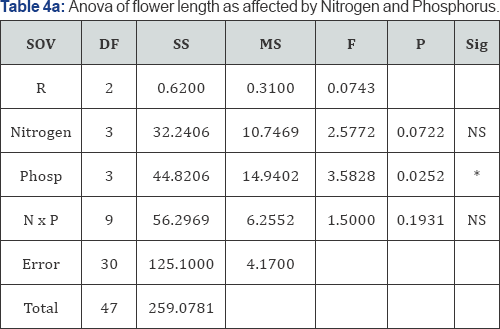
CV.22.0
Flower fresh weight (g)
The data in (Table 5) clarified the mean value for flower fresh weight and Table-5a reviled the analysis of variance. The ANOVA showed that the effect of Nitrogen and Phosphorus was significant, while their interaction was found non-significant. The mean value showed that the maximum flower fresh weight (52g) was observed at N2 (45) level, followed by (45.83g) at N1 (30) level, while the minimum flower fresh weight was found at control level. In case of phosphorus the maximum flower fresh weight (54g) was found at P3 (50), followed by (47g) at P3 (75) level, while the lowest flower fresh weight was found at control level. Phosphorus has a significant role in flower formation and reproductive growth [12]. Development and growth of flower is facilitated by ATPs and the Phosphorus is the major component of ATPs which help to increase flower fresh weight [9,12] also found the similar result. Nitrogen increase vegetative growth which in turn enhance floral development and consequently increase flower weight [14].
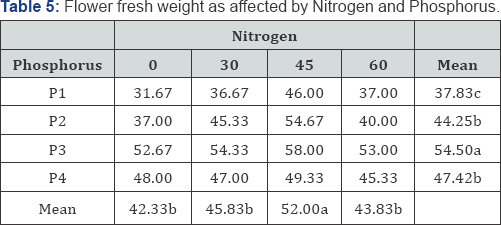
LSD@ 0.05 for N and P=3.7
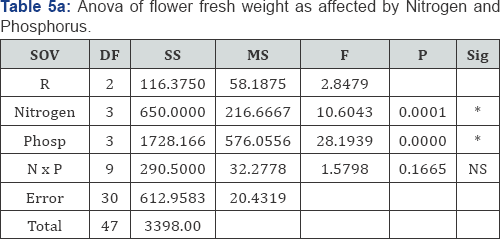
Root length (cm)
The data in (Table 6) manifested the mean value for root length, and (Table 6a) showed the analysis of Variance. The ANOVA showed that the effect of Nitrogen and Phosphorus was significant, while their interaction was found non-significant. For root length among the mean value of Nitrogen, showed that the maximum root length (25.33cm) was found at N2 (45), followed by (21.67cm) and (21.42cm) at N1 (30) and N3 (60), while the minimum root length was found at control level. In case of phosphorus the maximum root length (24.42cm) was observed at P2 (50), followed by (21.58cm) and (21.17cm) at P1 (25) and P3 (75) level, while the minimum root length (18.57cm) was found at control level. Phosphorus plays an important role in the vigour growth it has an essential role in transport of nutrient water and energy reaction hence increase root length [8] same result was found by [15] who reported that phosphorus can significantly increase root length as compare to control. Bolan NS [16] also found the same result.
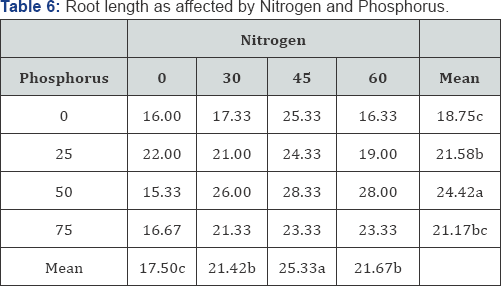
LSD @ at 0.05 for N and P= 2.76 and N*P=5.52

CV.15.42
Conclusion
Therefore it is concluded that Nitrogen at a rate of 45 and 60 was most effective to enhance the production of cockscomb. Maximum value number of leaves, leaf length, leaf fresh weight, flower length, flower fresh weight, and root length of cockscomb flower. Phosphorus at a rate 50 and 75 was the best to enhance the maximum number of leaves, leaf length, leaf fresh weight, flower length, flower fresh weight, and root length of cockscomb flower.
Recommendation
On the basis of obtained results and conclusions, the following recommendation can be made
a) Nitrogen should be applied at 45 kg ha-1 for better growth of cockscomb flower.
b) Phosphorus at 50 kg ha-1 for the better growth and flowering of cockscomb.
References
- Khoshoo TN, Pal M (2008) The probable origin and relationship of the garden cockscomb Botanical Journal of the Linnean Society 66(2): 127-141.
- Mark W, Guuliano W, Scot S (2006) Jugar diet in the cockscomb basin wild life sanctuary, beliz 38(5): 687-690.
- Alan R, Nottingham JR (2009) Potassium and its role in crop growth. Dawn Newspaper.
- Verlinden S, Mc donald L (2007) Productivity and quality of statice and Cockscomb under organic and inorganic fertilization regiments. 114(3): 199-206.
- Al-fraihat AH (2009) Effect of different nitrogen and sulphur fertilizer levels on growth, yield and quality of onion (AHium cepa L.). Jordan Journal of Agricultural Sciences 5(2): 217-226.
- Nasreen S, Haque M, Hossain MA, Farid ATM (2007) Nutrition uptake and yield of onion as influence by nitrogen and sulphur fertilization. Bangladesh J Agri Res 32(3): 413-420.
- Vachhani MU, and Patel ZO (1993) Effect of nitrogen, phosphorus, and potash on bulb yield and quality of onion. Indian J Agron. 3: 333-334.
- Better Crops (1999) Function of phosphorus in plant. International plant Nutrition Institute publication 83(1): 11-13.
- El-Naggar AH (2009) Response of Dianthus caryophyllus L. plant to foliar nutrition. World Journal of Agricultural Sciences 5(5): 622-630.
- Mengel K, Kirkby EA (1987) Principal of plant nutrition. 4th edn. International Potash institute.
- Javid QA, Abbasi NA, Saleem N, Hafiz IA, Mughal AL (2005) Effect of NPK Fertilizer on performance of Zennia (zinnia elegans) wirlying shade. International Journal of Agriculture & Biology 7(3): 471-473.
- Malik M (1994) Horticulture. 1st edn. National Book Foundation, Pakistan, pp. 508-509.
- Gangwar APS, Singh JP, Umaro VK, Singh IP (2012) Effect of nitrogen and Phosphorus with nitrogen sources on vegetative attributes of tube rose. Hort Flora Research Spectrum 1(4): 348-353.
- Larikl KK, Kakar MA, Shaikh MA (1999) Effect of nitrogen and potassium fertilizer On morphological traits on Zennia elegans. Pak J Agri Sci 36(1-2): 20-22.
- Khan J, Sajid M (2013) Effect of organic and inorganic phosphorus on growth of Rossele Hibiscus sabdariffa L. MSc thesis submitted to the University of Agriculture, Peshawar.
- Bolan NS, Robson AD, Barrow NJ (1987) Effects of phosphorus application and My corrhizal inoculation on root characteristics of subterranean clover and rye Grass in relation to phosphorus uptake. Plant and Soil 104(2): 294-298.






























